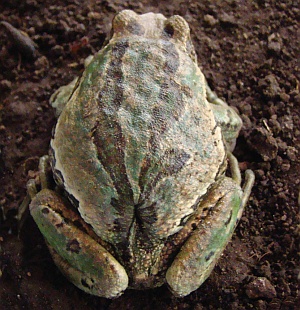Mar. 22, 2013 Research Highlight Biology
Decoding developmental differences
Differences between frog species reveal how developmental patterns are related to species diversity
 Figure 1: A brooding female of the marsupial frog Gastrotheca riobambae. The embryos develop slowly inside a pouch derived from the dorsal skin of the female. The outlines of the large embryos enclosed in the maternal pouch are visible. © 2013 E. M. del Pino
Figure 1: A brooding female of the marsupial frog Gastrotheca riobambae. The embryos develop slowly inside a pouch derived from the dorsal skin of the female. The outlines of the large embryos enclosed in the maternal pouch are visible. © 2013 E. M. del Pino
The development of embryos follows different patterns in different species, with specific events taking place at different times in relation to each other. Such differences can provide insight into how processes in development fit together, and how developmental patterns relate to reproductive adaptations.
Christian Mitgutsch from the Laboratory for Evolutionary Morphology at the RIKEN Center for Developmental Biology, working with researchers Eugenia M. del Pino and Natalia Sáenz-Ponce from the Pontifical Catholic University of Ecuador, has now investigated developmental timing across different species of frogs1. The research team demonstrated differences according to the overall rate of development, linking developmental patterns to reproductive adaptations.
Different developmental rates are likely to be evolutionary responses to reproductive strategies and environmental conditions. “For example, development is accelerated in frogs that require rapid development of a free-living tadpole,” says Mitgutsch. In contrast, embryos of the marsupial tree frog Gastrotheca riobambae (Fig. 1) develop inside a dorsal pouch of the mother where they are protected and can develop slowly.
Six frog species with different developmental rates were chosen for investigation. The rates were defined as the time required to progress from fertilization to the end of gastrulation. Three of the frog species that were investigated develop rapidly, completing gastrulation in just a few hours. The other three develop slowly, taking several days to reach the same stage.
“Gastrulation is a developmental process in multicellular animals during which germ layers are formed,” says Mitgutsch. “These layers are groups of cells that give rise to the different tissues and organs.”
Elongation of the embryo is a major developmental event, occurring when the earliest form of the spinal column, called the notochord, forms and extends. The researchers investigated elongation in their six frog species using protein labeling to watch the development of the head and precursors of the trunk. They found distinct differences in timing between the slowly and rapidly developing species.
“In frogs that develop rapidly, body elongation is superimposed upon the process of gastrulation, and there is acceleration of head development,” says Mitgutsch. “In our slowly developing frogs, body elongation occurs after completion of gastrulation, with a relative delay in the development of trunk structures.”
Mitgutsch explains that differential timing of developmental processes in different species can be related to growth and life history modes. “Learning about the differences provides information about how amphibian species-specific development evolved. We can generally better understand early development and learn how the diversity of frog species is realized developmentally.”
References
- 1. Saenz-Ponce, N., Mitgutsch, C. & del Pino, E.M. Variation in the schedules of somite and neural development in frogs. Proceedings of the National Academy of Sciences USA 109, 20503–20507 (2012). doi: 10.1073/pnas.1219307110
